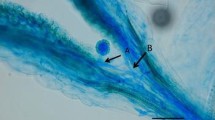Summary
Stylar self-incompatibility barriers in L. peruvianum can be avoided if pollen germination and growth through immature pistils is promoted under specific environmental conditions approximately 2–3 days before the initiation of anthesis. Since immature stigmas lack sufficient exudate for pollen germination, the sandwiching of a thin layer of pollen germination medium between the stigma and a mineral oil layer containing pollen allows precocious pollen germination and some compatible pollen tube growth through the style. This procedure is rapid, inexpensive, applicable in the field, and makes efficient use of pollen. Consistent though low seed yields have been obtained. A high proportion of aborted seed, seedling lethals, and aberrant seedling phenotypes in selfed progeny indicate the presence of strong post-zygotic barriers to such selfing. No evidence for a reduction in the strength of the SI response with increasing pistil age was observed.
Similar content being viewed by others
References
Attia MS, Munger HM (1950) Self-incompatibility and the production of hybrid cabbage seed. Proc Am Soc Hortic Sci 56:363–368
Brewbaker JL, Kwack BH (1963) The essential role of calcium ion in pollen germination and pollen tube growth. Am J Bot 50:859–865
Dumas C, Rougier D, Zandonella P, Ciampolini F, Cresti M, Pacini E (1978) The secretory stigma in Lycopersicon peruvianum Mill.: ontogenesis and glandular activity. Protoplasma 96:173–187
East EM (1934) Norms of pollen tube growth in incompatible matings of self-sterile plants. Proc Natl Acad Sci USA 20:225–230
Gradziel TM, Robinson RW (1985) Overcoming stylar incompatibility in Solanum and Lycopersicon by using bud-pollination under high humidity. Plant Cell Incompatibility Newslettl 17:13
Gradziel T, Robinson RW (1986) Overcoming pollination barriers in the Solanaceae. In: Proceedings of the XXII International Horticultural Congress, p 249 (abstr)
Heslop-Harrison J, Heslop-Harrison Y (1985) Surfaces and secretions in the pollen-stigma interaction: a brief review. J Cell Sci [Suppl] 2:287–300
Hogenboom NG (1972a) Breaking breeding barriers in Lycopersicon. I. The genus Lycopersicon its breeding barriers and the importance of breaking these barriers. Euphytica 21:221–227
Hogenboom NG (1972b) Breaking breeding barriers in Lycopersicon. II. Breakdown of self-incompatibility in L. peruvianum (L.) Mill. Euphytica 21:228–243
Hogenboom NG (1972c) Breaking breeding barriers in Lycopersicon. III. Inheritance of self-compatibility in L. peruvianum (L.) Mill. Euphytica 21:244–256
Hogenboom NG (1972d) Breaking breeding barriers in Lycopersicon. IV. Breakdown of unilateral incompatibility between L. peruvianum (L.) Mill, and L. esculentum. Euphytica 21:397–404
Kho YO, Baer J (1968) Observing pollen tubes by means of fluorescence. Euphytica 17:298–302
Konar RN, Linskens HF (1966a) The morphology and anatomy of the stigma of Petunia hybrida. Planta 71:356–371
Konar RN, Linskens HF (1966b) Physiology and biochemistry of the stigmatic fluid of Petunia hybrida. Planta 71:372–387
Lamm R (1950) Self-incompatibility in Lycopersicon peruvianum Mill. Hereditas 36:509–511
Maheswaran G, Ferryman T, Williams EG (1986) Use of an interspecific hybrid in identifying a new allelic specificity generated at the self-incompatibility locus after inbreeding in Lycopersicon peruvianum. Theor Appl Genet 73:236–245
Martin FW (1961) The inheritance of self-incompatibility in hybrids of Lycopersicon esculentum Mill, x L. chilense Dun. Genetics 46:1443–1454
McGuire D, Rick CM (1954) Self-incompatibility in species of Lycopersicon sect, Eriopersicon and hybrids with Lycopersicon esculentum. Hilgardia 23:101–124
Nettancourt D de (1977) Incompatibility in angiosperms. (Monographs on theoretical and applied genetics, vol 3) Springer, Berlin Heidelberg New York
Pandey KK (1959) Mutations of the self-incompatibility gene (S) and pseudo-compatibility in angiosperms. Lloydia 22:222–234
Shivanna KR, Rangaswamy NS (1969) Overcoming self-incompatibility in Petunia axillaris. I. Delayed pollination with stored pollen and bud pollination. Phytomorphology 19:372–380
Tanksley SD, Loaiza-Figueroa F (1985) Gametic self-incompatibility is controlled by a single major locus on chromosome 1 in Lycopersicon peruvianum. Proc Natl Acad Sci USA 82:5093–5096
Williams EG, Knox RB (1982) Quantitative analysis of pollen tube growth in Lycopersicon peruvianum. J Palynol 18:65–74
Yasuda S (1934) Physiological research on self-incompatibility in Petunia violacia. Bull Coll Agric For Morioka 20:1
Author information
Authors and Affiliations
Rights and permissions
About this article
Cite this article
Gradziel, T.M., Robinson, R.W. Breakdown of self-incompatibility during pistil development in Lycopersicon peruvianum by modified bud pollination. Sexual Plant Reprod 2, 38–42 (1989). https://doi.org/10.1007/BF00190117
Issue Date:
DOI: https://doi.org/10.1007/BF00190117




